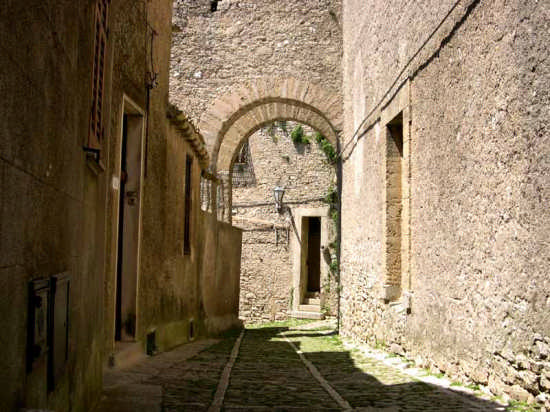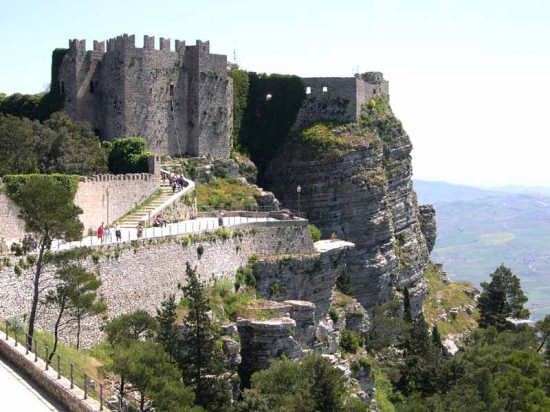Erice
 |
 |

ERICE, borgo di origine medievale si snoda tra vicoli lastricati, silenziosi e puliti, che conducono a slarghi inaspettati, ad ameni cortili fioriti ed a una grande quantità di splendide chiese. Sulla cima di un'alta montagna (il monte San Giuliano 751 mt.) a pochi Km da Trapani, Erice offre panorami mozzafiato ed oltre a numerose iniziative culturali di altissimo livello vi ha sede il Centro Internazionale di Cultura Scientifica Ettore Majorana, fondato da Antonio Zichichi. Oltre che per le sue numerose attrazioni monumentali ed architettoniche, Erice è famosa per il suo artigianato locale (sopratutto arazzi e tappeti variopinti tessuti a mano e ceramiche finemente decorate), per la sublime pasticceria a base di mandorle (non dimenticate di assaggiare le sublimi genovesi da Maria Grammatico) e per il liquore ericino.
ERICE si affaccia sul mare ad oriente verso il promontorio dello Zingaro con la sua riserva naturale e la costa di San Vito lo Capo, mentre dai giardini del Castello, lo splendido Balio, guardando verso valle brillano le saline di Trapani più in lontananza le Isole dello Stagnone.
Più ad occidente avvolta nella foschia le sagome di FAVIGNANA, MARETTIMO e LEVANZO che indicano i luoghi dove da secoli si consuma l'antico rito sanguinario e sensuale della Tonnara.

Superficially, it is the epitome of the Middle Ages, beginning with the castles, walls and stone streets. In reality, it's much older. This singular city, located on a mountain overlooking the Tyrrhenian coast of western Sicily, was ancient Eryx, a prosperous Elymian and Carthaginian city, boasting a well-known temple to a Phoenician fertility goddess, Astarte (later identified with Venus and worshipped by the Romans) and its own eponymous --if mythical-- hero, the Elymi ruler Eryx. Both Hercules and Aeneas are associated with ancient Erice. According to Diodorus Siculus, Eryx received Heracles (Hercules) on his visit to this part of Sicily, and lost to him in a wrestling bout. As Eryx would have been a son of Aphrodite and King Butes of the Elymians, Virgil identifies him as a brother of Aeneas.
Unfortunately, little is known of the Elymians. Originally from Asia Minor (possibly Anatolia), they arrived in Sicily to settle some of the island's western regions around 1200 BC (BCE), during more-or-less the same period that the Sicels, migrating from peninsular Italy, colonised the northeastern part of the island. Both coexisted with the native Sicanians. During the Greek domination most of the Elymians, including those of Segesta (Egesta), assimilated culturally with the Greeks. Evidence suggests that the Elymians of Eryx, however, assimilated more readily with the Punic culture of the Carthaginians.
The Phoenicians, Carthaginians and Romans, in turn, conquered the city, which never developed a particularly strong Greek culture except for that of the medieval Byzantines of the Eastern Roman Empire. To the Arabs, Erice was an important foothold known as Gebel Hamed, which the Normans christened Monte San Giuliano, a name by which it was known until 1934, when it was given its original Latin nomenclature.
Standing atop a mountain (around 750 metres above sea level) overlooking nearby Trapani and the beaches of San Vito Lo Capo, delightful Erice is almost something of a western Sicilian Taormina. There are some ancient Elymian and Phoenician walls surrounding the northeastern side of the city, and two castles, Pepoli Castle, with foundations dating from Arab times, and nearby Venus Castle, dating from the Norman period but built on ruins of the ancient Temple of Venus. Surrounded by a lush park, the hilltop castles alone are worth a stop in Erice, which offers charming old stone streets and several medieval churches. Pepoli Castle was at first a feudal stronghold, though Erice was eventually ceded to the Crown as a demesnial city. The view from the castle towers is stupendous. Though both castles have been modified somewhat over the centuries, they still have that distinctively medieval character one expects of such fortresses. (Pepoli Castle is now a hotel.)
The town is by no means overlooked by the annals of history. Strabo, Pliny and Tacitus wrote of it. Thucydides mentions the Elymians of Eryx and Egesta (Segesta). In 406 BC, an important sea battle took place in the nearby waters between fleets of Carthage and a Syracuse, with the latter winning. Later, in the First Punic War, Eryx fell to the Carthaginians, and in 260 BC Hamilcar destroyed it. It was much contested by Greeks, Carthaginians and Romans, then reached by the Arabs in the chaotic years following 827 as part of their drive toward Palermo and other parts of western Sicily. Writing in the twelfth century, the Arab geographer Idrisi observed that the women in this town were among the most beautiful in Sicily. Later, Ibn Jubayr also wrote about it.
Ecclesiastical architecture is not absent from Erice. The Mother Church, on Via Carvini, is essentially a fourteenth-century proto-Gothic structure whose style reflects certain Romanesque influences. An older tower stands at the entrance, and the church itself was built upon a much earlier structure. The medieval Church of Saint John the Baptist was modified in recent centuries but still retains something of its original style, especially its exterior. It was built as an Orthodox chapel. The fifteenth century Church of Saint Ursula, which also retains some medieval Gothic elements, is worth a visit.
Depending on your route, the trek to Erice from nearby Trapani will take you several miles up winding roads or, alternately, along a convenient cableway. The Cordici Civic Museum in Piazza Umberto I houses some interesting finds from the area. Its Carthaginian ("Punic") collection is remarkable, but the Greek and Roman pieces are also interesting.
Except in summer, Erice is often covered in fog even when there's sunshine bathing the surrounding areas, and this may limit the views of the coast and valleys below. That said, spring and autumn are the perfect seasons to visit.
You'll find some good restaurants in Erice, which makes a pleasant stop on the way to Trapani, Marsala and Favignana. Couscous with fish is a local specialty. There are also several exceptional pastry shops, including Maria Grammatico's in the centre of town.